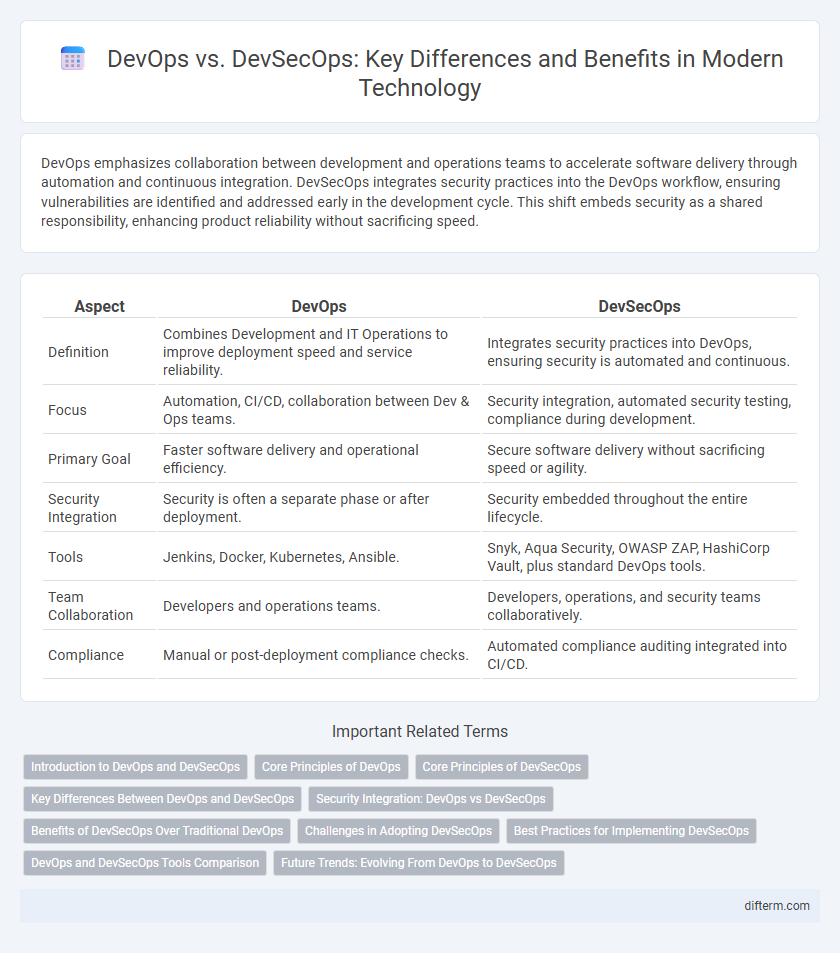DevOps emphasizes collaboration between development and operations teams to accelerate software delivery through automation and continuous integration. DevSecOps integrates security practices into the DevOps workflow, ensuring vulnerabilities are identified and addressed early in the development cycle. This shift embeds security as a shared responsibility, enhancing product reliability without sacrificing speed.
Table of Comparison
| Aspect | DevOps | DevSecOps |
|---|---|---|
| Definition | Combines Development and IT Operations to improve deployment speed and service reliability. | Integrates security practices into DevOps, ensuring security is automated and continuous. |
| Focus | Automation, CI/CD, collaboration between Dev & Ops teams. | Security integration, automated security testing, compliance during development. |
| Primary Goal | Faster software delivery and operational efficiency. | Secure software delivery without sacrificing speed or agility. |
| Security Integration | Security is often a separate phase or after deployment. | Security embedded throughout the entire lifecycle. |
| Tools | Jenkins, Docker, Kubernetes, Ansible. | Snyk, Aqua Security, OWASP ZAP, HashiCorp Vault, plus standard DevOps tools. |
| Team Collaboration | Developers and operations teams. | Developers, operations, and security teams collaboratively. |
| Compliance | Manual or post-deployment compliance checks. | Automated compliance auditing integrated into CI/CD. |
Introduction to DevOps and DevSecOps
DevOps integrates software development and IT operations to enhance collaboration, accelerate delivery, and improve system reliability through continuous integration and continuous deployment (CI/CD) pipelines. DevSecOps builds on DevOps by embedding security practices into every phase of the development lifecycle, promoting proactive vulnerability management and compliance automation. This approach reduces risks by integrating automated security testing, threat modeling, and security monitoring directly into DevOps workflows.
Core Principles of DevOps
The core principles of DevOps center on continuous integration, continuous delivery, and automation to enhance collaboration between development and operations teams, ensuring faster and more reliable software releases. DevOps emphasizes infrastructure as code, monitoring, and feedback loops to streamline deployment pipelines and improve system stability. Unlike DevSecOps, which integrates security practices into every stage of the development lifecycle, DevOps primarily focuses on accelerating development workflows and operational efficiency.
Core Principles of DevSecOps
DevSecOps integrates security practices directly into the DevOps workflow, emphasizing automation, continuous monitoring, and collaborative responsibility among development, security, and operations teams. Core principles include shifting security left to detect vulnerabilities early, embedding automated security testing within CI/CD pipelines, and fostering a culture of shared accountability for security across all stages of software development. This approach enhances application security without compromising the velocity and agility that DevOps aims to achieve.
Key Differences Between DevOps and DevSecOps
DevOps emphasizes collaboration between development and operations teams to streamline software delivery, focusing on continuous integration and continuous deployment (CI/CD) pipelines. DevSecOps integrates security practices directly into the DevOps workflow, ensuring automated security testing, vulnerability management, and compliance checks throughout the software development lifecycle. The key differences lie in DevSecOps' proactive security embedding versus DevOps' primary focus on speed and operational efficiency.
Security Integration: DevOps vs DevSecOps
DevSecOps integrates security practices directly into the DevOps pipeline, ensuring continuous vulnerability assessment and automated compliance checks throughout the software development lifecycle. Unlike traditional DevOps, which primarily focuses on collaboration between development and operations teams to speed up deployment, DevSecOps embeds security as a shared responsibility across all stages of development. This proactive security integration reduces risks, prevents breaches, and aligns with modern regulations such as GDPR and HIPAA more effectively than reactive security measures.
Benefits of DevSecOps Over Traditional DevOps
DevSecOps integrates security practices directly into the software development lifecycle, reducing vulnerabilities and enhancing compliance compared to traditional DevOps. This approach enables faster detection and remediation of security flaws through automated security testing and continuous monitoring. By embedding security from the start, DevSecOps minimizes risk and lowers costs associated with late-stage security fixes and breaches.
Challenges in Adopting DevSecOps
Adopting DevSecOps introduces significant challenges such as integrating comprehensive security practices without disrupting agile workflows, which often requires extensive training and cultural shifts within development teams. The complexity of automating security testing and continuous monitoring across diverse environments demands advanced tooling and expertise that many organizations lack. Balancing speed, security, and collaboration among development, operations, and security teams remains a critical hurdle in achieving effective DevSecOps implementation.
Best Practices for Implementing DevSecOps
Implementing DevSecOps best practices involves integrating security early into the software development lifecycle by automating security testing and continuous monitoring using tools like SAST, DAST, and container security scanners. Collaboration between development, security, and operations teams through shared responsibility models and regular security training enhances threat detection and mitigation. Leveraging Infrastructure as Code (IaC) and compliance-as-code ensures consistent security policies are enforced, while real-time vulnerability management reduces risk in CI/CD pipelines.
DevOps and DevSecOps Tools Comparison
DevOps tools like Jenkins, Docker, and Kubernetes streamline continuous integration, delivery, and infrastructure automation, enhancing rapid software development. DevSecOps integrates security tools such as SonarQube, Aqua Security, and Snyk into the DevOps pipeline, embedding vulnerability scanning and compliance checks early in the lifecycle. While DevOps emphasizes development and operations efficiency, DevSecOps prioritizes proactive security measures within the CI/CD process for comprehensive application protection.
Future Trends: Evolving From DevOps to DevSecOps
Future trends indicate a significant shift from traditional DevOps to DevSecOps as cybersecurity becomes an integral part of the software development lifecycle. Organizations increasingly adopt automated security tools and continuous monitoring within DevSecOps pipelines to detect vulnerabilities early and ensure compliance. This evolution enhances collaboration between development, security, and operations teams, driving faster, safer software delivery in cloud-native and microservices architectures.
DevOps vs DevSecOps Infographic

 difterm.com
difterm.com